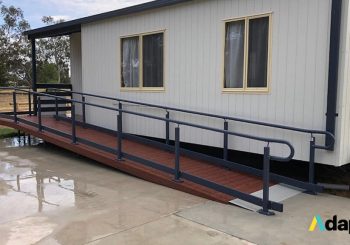Handrails are an essential part of any property’s outdoor steps, providing safety and support to everyone who visits or lives there. Despite their importance, handrails are often overlooked in the design or redesign of a property. In this post, we will discuss the importance of handrails, especially for safety and stability.
 Handrails provide support
Handrails provide support
Handrails provide support to people of all ages and abilities, from toddlers to the elderly and those with mobility, balance, or visual impairments. Young children learn to navigate outdoor steps with the help of handrails, while the elderly rely on them for additional support in balancing.
People with vertigo or a fear of heights can also benefit from handrails, which provide peace of mind and added security when using stairs. Additionally, handrails are helpful for pets spending time outdoors, too.
Prevent Injuries
Handrails help prevent injuries by providing something to hold onto in case of accidents. Falling or slipping down steps can result in serious injuries if there are no handrails in place. In addition, they can minimise accidents and injuries by offering added support to people carrying large or multiple items as well as those who are rushing while going up or down the stairs.
Useful during Extreme Weather Conditions
Handrails are particularly useful during extreme weather conditions, such as rainy or winter seasons, when outdoor steps can become slippery. They can provide an additional layer of safety for residents and guests going in and out of your property.
Improve the overall aesthetic of a property
Handrails improve the overall aesthetic of a property by complementing balcony railings and completing the exterior design of homes and other structures. They come in different materials, colours, styles, and designs to match the property.
To ensure that handrails provide maximum safety and security, keep in mind these three key items when choosing and installing handrails:
(1) Check your local building codes to ensure that your handrails meet regulations for properties, including residential or commercial buildings, decks, or stairways. The NSW government provides guidelines on stairs and handrails. These state that:
- Each stairway should be installed with at least one handrail, and those that are wider than 1, 000mm should have handrails on both sides.
- The handrails must also be
- between 900mm and 1,100mm above the floor or the nosing of a stair tread
- must be easily seen, with colour in contrast with its surrounding
- must follow a minimum hand clearance of 50mm between the handrail and the adjacent structure, with no sharp edges that may cause injury
- must not be obstructed and should provide unrestricted movement of the hand throughout the length of the handrail
Read DDA and Australian Standard for Handrails
(2) Choose a reputable manufacturer of reliable and durable handrails, such as Adapta Ramps. We create handrails that seamlessly fit into pre-existing or new ramps and steps, providing stability and safety.
(3) Ensure that the handrails are properly installed to ensure their effectiveness. Go for handrails that are easy to install, versatile, and come with all the necessary parts and hardware for a hassle-free installation process.
Investing in new handrails is an important step in enhancing your property’s safety and overall design and functionality. To learn more about Adapta Ramps’ handrails and how they can promote safety and inclusive accessibility on your property, contact us through our website today.



